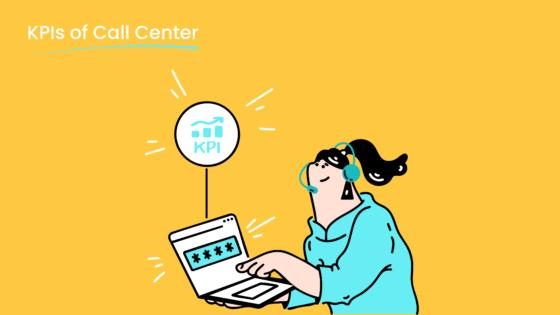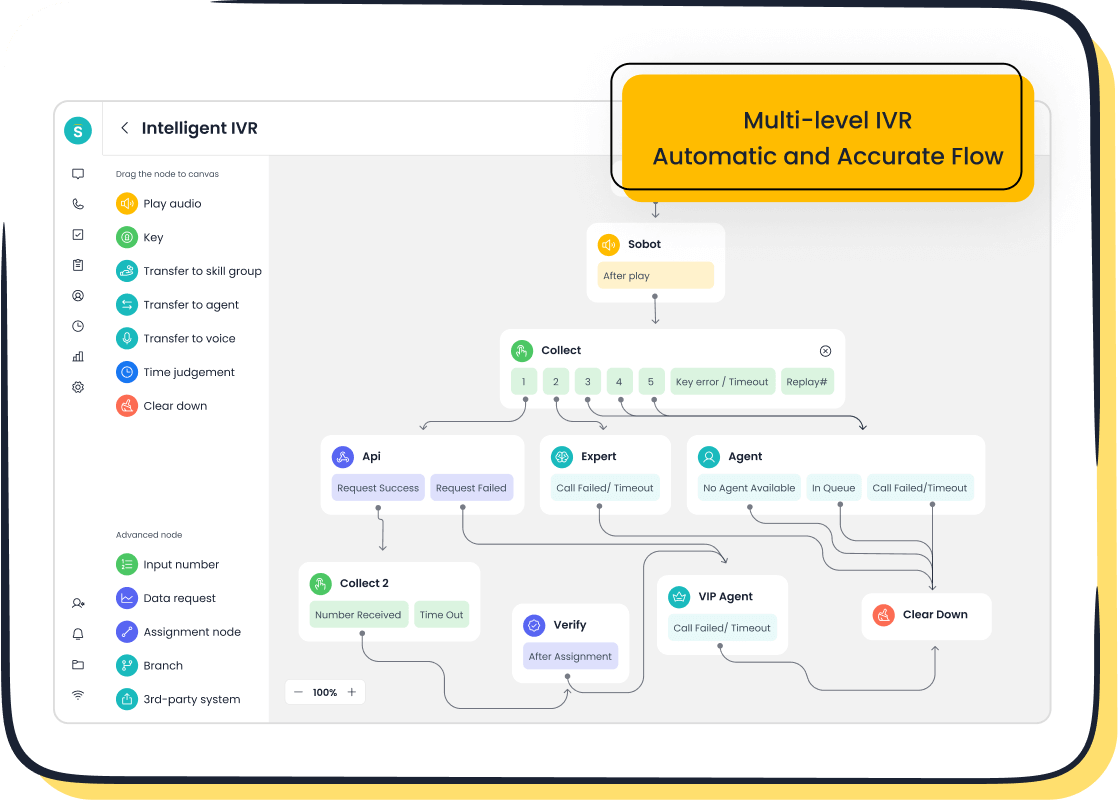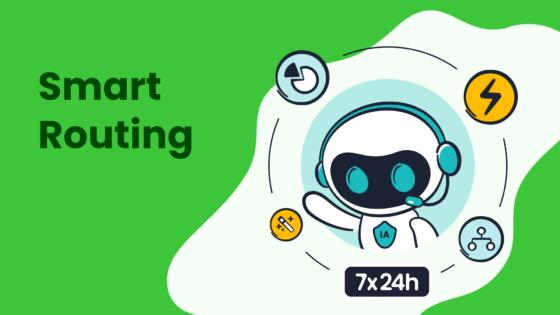Key Strategies to Align KPIs with Customer Service Goals

Aligning customer service KPIs with your business goals plays a crucial role in driving success. Metrics like Customer Satisfaction (CSAT) scores aim for excellence at 85-90%, while Net Promoter Scores (NPS) above 50 reflect strong customer loyalty. Faster average resolution times and higher First Contact Resolution rates further boost satisfaction. These alignments not only enhance customer experiences but also improve operational efficiency by reducing costs per contact and lowering average handle times.

Sobot, a leader in customer service solutions, offers tools like its Voice/Call Center to help you monitor and align KPIs in real time. With features like intelligent IVR and call tracking, Sobot empowers your team to deliver exceptional service while achieving measurable results.
Understanding Customer Service KPIs

What Are Customer Service KPIs?
Customer Service KPIs are measurable metrics that help you evaluate the effectiveness of your customer service efforts. These indicators provide insights into how well your team meets customer expectations and achieves business objectives. By tracking KPIs, you can identify areas for improvement and ensure your service aligns with customer needs. For example, metrics like the Customer Satisfaction Score (CSAT) and First Contact Resolution (FCR) reveal how satisfied customers are and how efficiently their issues are resolved.
KPIs act as a compass, guiding your team toward delivering exceptional service. They help you focus on what matters most—improving customer experiences and building loyalty.
The Role of KPIs in Measuring and Improving Customer Service Performance
KPIs play a critical role in measuring and enhancing customer service performance. They provide a clear picture of how your team performs and where adjustments are needed. For instance:
- The integration of AI and agility in KPI management significantly boosts business performance.
- Companies with well-defined KPIs experience a 5% higher return on equity, showing a strong link between effective KPIs and financial success.
- AI-enhanced analytics and agile methodologies are now essential for adapting to changing market conditions.
By monitoring KPIs, you can make data-driven decisions to improve response times, reduce customer effort, and enhance satisfaction. This approach ensures your team remains proactive and aligned with customer expectations.
Common Customer Service KPIs
Several KPIs are widely recognized for evaluating customer service effectiveness. Here are some key examples:
| KPI | Definition | Calculation Formula |
|---|---|---|
| First Contact Resolution | Percentage of customer issues resolved on the first contact. | (Number of Issues Resolved on First Contact / Total Number of Issues) x 100 |
| Net Promoter Score | Evaluates customer loyalty by asking how likely they are to recommend. | % Promoters - % Detractors |
| Customer Effort Score | Measures the effort put by customers in solving a problem. | N/A |
Each KPI serves a unique purpose. For example, the Customer Satisfaction Score (CSAT) measures how satisfied customers are after interacting with your team. A sudden drop in CSAT should prompt immediate action to uncover and address underlying issues. Similarly, First Response Time (FRT) highlights how quickly your team responds to customer inquiries, which directly impacts satisfaction.
Luis Hernandez, VP of Customer Success at Geckoboard, emphasizes that "timeliness and speed have a direct correlation with satisfaction." A fast first response creates a positive impression, setting the stage for a successful resolution.
Defining Key Customer Service Goals
Enhancing Customer Satisfaction and Loyalty
Customer satisfaction and loyalty are the cornerstones of successful service strategies. When you prioritize these goals, you create lasting relationships that drive business growth. Research shows that 73% of business leaders believe customer service directly impacts performance, with 64% attributing growth to effective service strategies.
To improve satisfaction, focus on reducing customer effort during interactions. High-effort experiences lead to disloyalty in 96% of cases, while low-effort experiences foster loyalty in 91%. Simple steps like streamlining processes and offering personalized solutions can make a significant difference.
Tip: A 5% increase in customer retention can boost profits by 25% to 95%. By listening to customer feedback and addressing pain points, you can turn satisfied customers into loyal advocates for your brand.
Reducing Response and Resolution Times
Quick response and resolution times are essential for delivering quality service. Customers value speed and efficiency, and reducing wait times enhances their experience. Strategic alignment of KPIs like First Call Resolution and Average Response Time can help you achieve this goal.
| Case Study | Outcome |
|---|---|
| Northmill | Improved customer conversion rates by 30%. |
| Various Studies | Reduced response times by 30% through training programs. |

By implementing comprehensive training for your team, you can ensure faster resolutions without compromising service quality. Tools like Sobot’s Voice/Call Center provide real-time monitoring and analysis, enabling you to track performance and make adjustments as needed.
Increasing Retention Rates and Long-Term Customer Value
Retention rates and customer lifetime value (CLV) are critical metrics for sustained success. Loyalty programs play a pivotal role in achieving these goals. For example, 75% of consumers are more likely to stick with brands offering rewards programs. Best Buy’s Rewards program increased annual spending by 15% among loyal customers.
Loyalty programs not only retain customers but also enhance CLV by encouraging deeper engagement and referrals. When customers feel valued, they stay longer, reducing acquisition costs and driving continuous improvement in revenue.
Note: Aligning KPIs with retention goals ensures you focus on strategies that build lasting relationships and maximize customer value over time.
Strategies to Align KPIs with Customer Service Goals
Mapping KPIs to Specific Customer Service Objectives
Mapping KPIs to your customer service objectives ensures that every metric aligns with your broader goals. This approach helps you focus on what truly matters—delivering value to your customers while driving measurable outcomes. For example, if your goal is to enhance customer retention, you might prioritize KPIs like Net Promoter Score (NPS) or Customer Lifetime Value (CLV). These metrics directly reflect loyalty and long-term engagement.
Consider the following case studies that demonstrate the power of aligning KPIs with specific objectives:
| Case Study | Objective | Actions Taken | Results |
|---|---|---|---|
| Stitch Fix | Increase customer retention by improving personalization | Used advanced algorithms for personalized recommendations | Significant increase in customer retention and lifetime value. |
| HubSpot | Improve customer onboarding to reduce churn | Redesigned onboarding process to be user-friendly and engaging | Measurable decrease in churn and higher customer satisfaction. |

These examples highlight how tailored strategies can transform customer service performance. By identifying your objectives and selecting the right KPIs, you create a roadmap for success. Tools like Sobot’s Voice/Call Center simplify this process by offering features such as call tracking and real-time monitoring. These capabilities allow you to measure key performance indicators effectively and adjust your strategies as needed.
Tip: Regularly review your KPIs to ensure they remain aligned with evolving customer expectations and business priorities.
Leveraging Customer Feedback to Refine KPI Selection
Customer feedback is a goldmine for refining your KPIs. It provides direct insights into what your customers value most, helping you focus on metrics that matter. For instance, analyzing feedback can reveal recurring pain points, enabling you to prioritize improvements that have the greatest impact on customer satisfaction.
Here are some analytical methods that show how feedback can enhance your KPI selection:
| Analytical Method | Benefit |
|---|---|
| Prioritize improvements | Rank issues based on frequency and severity of complaints to focus on impactful problems. |
| Predict future needs | Use predictive analytics to forecast customer behavior based on historical data. |
| Identify root causes | Map customer journeys to pinpoint pain points and gather more details from survey respondents. |
| Measure impact on CX | Analyze correlation between feedback and KPIs to refine metrics aligned with customer priorities. |
| Spot early warning signs | Monitor feedback for sudden increases indicating developing problems. |
| Inform strategic decisions | Use data-driven insights to guide product development and marketing strategies. |

For example, if customers frequently mention long wait times, you might refine your KPIs to include First Call Resolution or Average Response Time. Sobot’s Voice/Call Center can assist by providing real-time data analytics, enabling you to track these metrics and respond proactively.
Note: Leveraging customer feedback not only improves your KPIs but also enhances the overall customer experience by addressing their needs directly.
Using Sobot's Voice/Call Center for Real-Time KPI Monitoring and Analysis
Real-time monitoring and analysis are essential for maintaining high customer service standards. Sobot’s Voice/Call Center offers advanced tools to help you track and optimize your KPIs effortlessly. Features like intelligent IVR and unified workspaces allow your team to manage calls efficiently while accessing comprehensive customer data.
For instance, the platform’s call tracking feature provides detailed insights into call durations, resolutions, and customer satisfaction levels. This data helps you identify trends and make informed decisions to improve customer service performance. Additionally, the AI-powered Voicebot can handle repetitive queries, freeing your agents to focus on complex issues.
Sobot’s real-time monitoring capabilities also support continuous improvement. By analyzing live data, you can spot inefficiencies and adjust your strategies immediately. For example, if First Call Resolution rates drop, you can implement targeted training programs to address the issue.
Tip: Use Sobot’s analytics to create custom dashboards that display your most critical KPIs. This ensures your team stays focused on achieving your customer service goals.
Actionable Tips to Improve Customer Service Performance

Setting SMART KPIs for Customer Service Teams
Setting SMART (Specific, Measurable, Achievable, Relevant, Time-bound) KPIs ensures your customer service team focuses on clear and attainable goals. This methodology helps you align metrics with broader objectives while maintaining a structured approach to performance management.
- Specific: Define precise goals, such as reducing First Response Time by 20%.
- Measurable: Use quantifiable metrics like Customer Satisfaction Score (CSAT) to track progress.
- Achievable: Set realistic targets based on historical data and current resources.
- Relevant: Ensure KPIs align with your customer service goals, such as improving retention rates.
- Time-bound: Establish deadlines to create urgency and accountability.
For example, reviewing current metrics and analyzing trends can help you identify areas for improvement. Continuous tracking of these metrics ensures your team stays on course. Tools like Sobot’s Voice/Call Center simplify this process by offering real-time monitoring and analytics, enabling you to measure and refine KPIs effectively.
Tip: Start small by focusing on one or two key metrics, then expand as your team becomes more comfortable with performance tracking.
Training Teams to Use KPIs Effectively
Effective training empowers your team to leverage KPIs for better customer service performance. A well-trained team understands how to interpret metrics and use them to enhance the customer experience.
| Metric | Description |
|---|---|
| Data-driven companies | 58% more likely to achieve revenue goals, indicating the importance of effective training. |
| Training budget expectations | 41% of leaders expect larger budgets, emphasizing the need for solid metrics to justify spending. |
| Key metrics for effectiveness | Participation Rate, Engagement Rate, Completion Rate, Skill Assessment Scores, Employee Retention. |
To improve training outcomes, focus on interactive methods like role-playing scenarios and hands-on workshops. For instance, training agents to use Sobot’s Unified Workspace can streamline their workflow by consolidating customer data and communication channels into one platform. This reduces the time spent switching between systems and enhances their ability to resolve issues efficiently.
Note: Regularly assess training effectiveness using metrics like skill assessment scores and employee retention rates. This ensures your team remains equipped to meet evolving customer expectations.
Regularly Reviewing and Adjusting KPIs with Tools Like Sobot's Unified Workspace
Regular reviews of your KPIs ensure they stay aligned with your customer service goals and adapt to changing needs. This process involves analyzing performance data, gathering customer feedback, and making adjustments to improve outcomes.
Sobot’s Unified Workspace simplifies KPI reviews by providing a centralized platform for monitoring metrics. Features like real-time dashboards and analytics allow you to track trends and identify areas for improvement. For example, if your Net Promoter Score (NPS) drops, you can use feedback data to pinpoint the issue and implement corrective actions.
Tip: Schedule monthly KPI reviews to stay proactive. Use Sobot’s tools to create custom dashboards that highlight your most critical metrics, ensuring your team remains focused on delivering exceptional service.
The Importance of Continuous Monitoring and Adjustment
Continuous monitoring and adjustment of KPIs are essential for maintaining high customer service standards. This practice ensures your team stays aligned with evolving customer expectations and business goals. By regularly reviewing performance metrics, you can identify successful strategies and areas needing improvement, fostering a culture of continuous enhancement.
Establishing a Routine for KPI Review
Establishing a routine for KPI review helps you stay proactive in addressing challenges and seizing opportunities. Regular reviews allow you to track trends, measure progress, and make informed decisions. For example, Marriott International aimed to improve its Customer Satisfaction (CSAT) scores by 10% within a year. By focusing on personalized guest experiences and leveraging historical data, they achieved an 11% improvement, exceeding their goal.
Consider the following insights that highlight the importance of routine KPI reviews:
| KPI | Insight |
|---|---|
| Resolution Time | A 10% decrease in average resolution time increases customer satisfaction rates. |
| Customer Loyalty Index | Loyal customers are five times more likely to repurchase and four times more likely to refer. |
| SLA Adherence | Compliance builds trust and enhances retention. |
Using tools like Sobot’s Unified Workspace simplifies this process. Its real-time dashboards and analytics provide a centralized platform for tracking and reviewing KPIs effectively.
Using Real-Time Dashboards for Insights (e.g., Sobot's Monitoring and Analysis Features)
Real-time dashboards offer instant visibility into your customer service operations. They enable you to monitor key metrics, identify underperforming areas, and make data-driven decisions immediately. For instance, manufacturing dashboards track machine efficiency and uptime, helping managers minimize downtime and improve productivity.
Sobot’s Voice/Call Center provides advanced monitoring and analysis features. These include call tracking, resolution time metrics, and customer satisfaction scores. By displaying these insights in real-time, the platform empowers your team to address issues proactively. For example, if response times increase, you can quickly adjust workflows or allocate additional resources to meet demand.
Tip: Use Sobot’s customizable dashboards to focus on the metrics that matter most to your business goals.
Adapting KPIs to Evolving Customer Expectations and Business Goals
Customer expectations and business goals evolve over time. Adapting your KPIs ensures your service remains relevant and effective. For example, organizations that align KPIs with market trends and customer feedback can set dynamic goals and improve satisfaction rates.
| Evidence Point | Description |
|---|---|
| Continuous Improvement | KPIs provide a basis for assessing the impact of changes and fostering growth. |
| Data-Driven Decisions | Trends and feedback help align initiatives with customer demands. |
| Customer-Centric Focus | Customer-focused KPIs enhance satisfaction and loyalty. |
Sobot’s solutions, such as its AI-powered Voicebot, help you adapt to these changes. The Voicebot handles repetitive queries, allowing agents to focus on complex issues. This flexibility ensures your team meets customer needs efficiently, even as expectations shift.
Note: Regularly update your KPIs to reflect new priorities and maintain alignment with your business objectives.
Aligning KPIs with customer service goals ensures measurable success. It helps you track performance, improve customer satisfaction, and achieve business growth. Continuous monitoring and adjustment keep your strategies relevant and effective.
| KPI Type | Importance |
|---|---|
| Response Times | Shows how quickly customer inquiries are addressed, improving satisfaction. |
| Resolution Rates | Measures the team's ability to solve issues effectively. |
| Customer Satisfaction Scores | Reflects customer emotions, helping you gauge service quality. |
| Net Promoter Scores | Tracks loyalty and the likelihood of recommendations, driving growth. |
| Accountability | Ensures team members understand their roles in meeting targets. |
| Continuous Improvement | Encourages better performance and adaptation to customer needs. |
Sobot’s Voice/Call Center offers tools like real-time monitoring and AI-powered Voicebots to help you achieve these goals. Explore Sobot’s solutions to enhance your customer service and drive long-term success.
FAQ
What are the benefits of aligning KPIs with customer service goals?
Aligning KPIs with your goals ensures measurable success. It helps you track performance, improve customer satisfaction, and identify areas for improvement. This alignment also enhances operational efficiency, enabling your team to deliver better results consistently.
How can Sobot’s Voice/Call Center help improve KPI tracking?
Sobot’s Voice/Call Center offers real-time monitoring and analytics. These tools allow you to track key metrics like resolution time and customer satisfaction. The platform also provides actionable insights, helping you make data-driven decisions to enhance performance.
Why is customer feedback important for refining KPIs?
Customer feedback reveals what matters most to your audience. It helps you identify pain points and prioritize improvements. By incorporating feedback into your KPI strategy, you ensure your metrics align with customer expectations and drive meaningful results.
How often should you review your KPIs?
You should review your KPIs monthly. Regular reviews help you track progress, adapt to changes, and ensure alignment with your goals. Tools like Sobot’s Unified Workspace simplify this process by providing real-time dashboards for easy monitoring.
What are SMART KPIs, and why are they important?
SMART KPIs are Specific, Measurable, Achievable, Relevant, and Time-bound. They provide clear, actionable goals for your team. This structure ensures focus and accountability, helping you achieve your customer service objectives effectively.
See Also
Essential QMS Strategies for Effective Call Center Management
Ten Strategies to Enhance Live Chat Customer Experience
Top Practices for Effective Call Center Quality Management
Ten Key Considerations for Selecting Social Media Support Tools
Enhancing Call Center Efficiency Through Effective Monitoring Techniques
